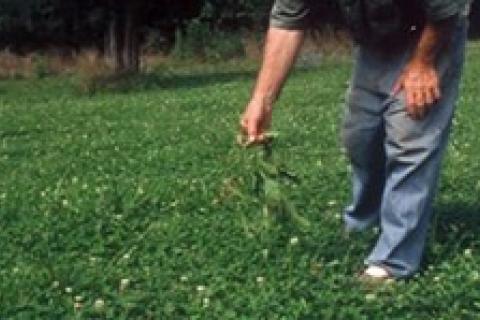
 When bass fishing legend Ray Scott began experimenting with seeds to improve the health and antler growth of the deer on his property many years ago, his efforts took him ultimately to one type of plant: ladino clover. That started the ball rolling for what has become a multi-million dollar industry of wildlife seed companies.
When bass fishing legend Ray Scott began experimenting with seeds to improve the health and antler growth of the deer on his property many years ago, his efforts took him ultimately to one type of plant: ladino clover. That started the ball rolling for what has become a multi-million dollar industry of wildlife seed companies.
Scott didn't just choose any ladino clover, though. He found deer preferred some over others. He experimented, hired biologists and agronomists, planting multiple test sites and eventually developed several different types of clover devised especially to appeal to the taste buds of whitetail deer, rather than cattle, which most clovers were created for.
His company, the Whitetail Institute of North America, headed up by himself and sons Steve and Wilson, now produces many other blends of wildlife eeds that will nurture deer 12 months of the year. The products include the best varieties they can get their hands on for each region of the country for seeds such as oats, turnips, chicory, small burnett, lablab, cowpeas, forage soybeans and others, as well as unique varieties of these plants that they develop themselves through years of extensive, in-the-field testing.
 I've tried most of these products and had excellent results, but among all of them, my favorite for early spring planting (and also late summer) is still their first product ever offered, Imperial Whitetail Clover. Of course this seed blend has been refined, redone and improved many times since I first started using it, but it never has failed to draw deer in and keep them healthy in all its various stages of development. It now contains several proprietary types of clover that their company created to appeal to the taste buds of whitetails and provide high levels of protein while being extremely hardy and drought-resistant.
I've tried most of these products and had excellent results, but among all of them, my favorite for early spring planting (and also late summer) is still their first product ever offered, Imperial Whitetail Clover. Of course this seed blend has been refined, redone and improved many times since I first started using it, but it never has failed to draw deer in and keep them healthy in all its various stages of development. It now contains several proprietary types of clover that their company created to appeal to the taste buds of whitetails and provide high levels of protein while being extremely hardy and drought-resistant.
Certainly other wildlife seed companies have excellent clover mixtures as well. You can also do fairly well planting just plain ladino clover. But once you find a seed mixture that works superbly on your property it's hard to change. That's why I stick with Imperial Whitetail.
Clover mixtures such as this are easy to grow, which is a big plus for people who don't have a lot of time to devote to their food plots. And it's the perfect choice if you're just getting into planting for deer. Even if you have just a spare quarter acre behind your house or a couple of acres in the country, that's enough land to put a clover plot in.
 The perennial plants will live for 3-7 years, depending on weed competition and how well they are maintained. Mowing the weed tops that grow above the clover is vital, or you can spray to remove competing grasses with selective herbicides such as Poast and Arrest.
The perennial plants will live for 3-7 years, depending on weed competition and how well they are maintained. Mowing the weed tops that grow above the clover is vital, or you can spray to remove competing grasses with selective herbicides such as Poast and Arrest.
Imperial Whitetail Clover has a high protein content, from 20-35 percent, and a high total digestible nutrient level of 70-80 percent. It also produces its own nitrogen and adds that to the soil, reducing fertilizer needs. You only need to add phosphate and potassium when fertilizing once or twice a year. I like to mix 0-46-0 and 0-0-60.
Make sure the pH is 6.5 or higher. Add lime if it's not. Now you're good-to-go with this easy to grow deer favorite.
Just be sure you follow their precise planting directions carefully as to when to put the seed in, how deep (1/4 inch or less) and how to firm the seed bed before and after planting by cultipacking.
- 3263 views

